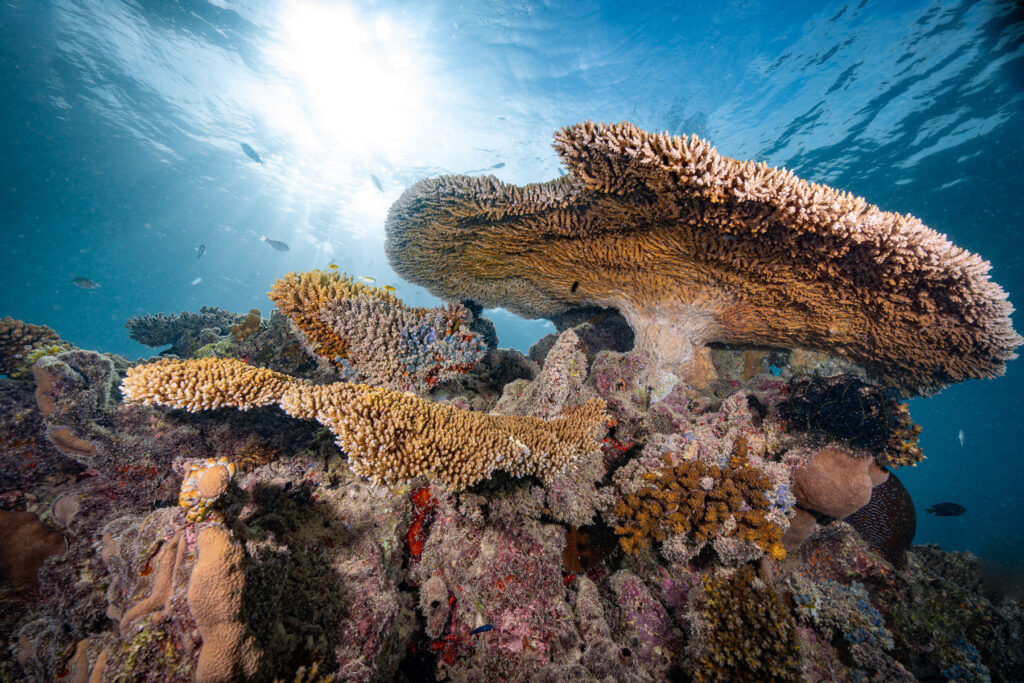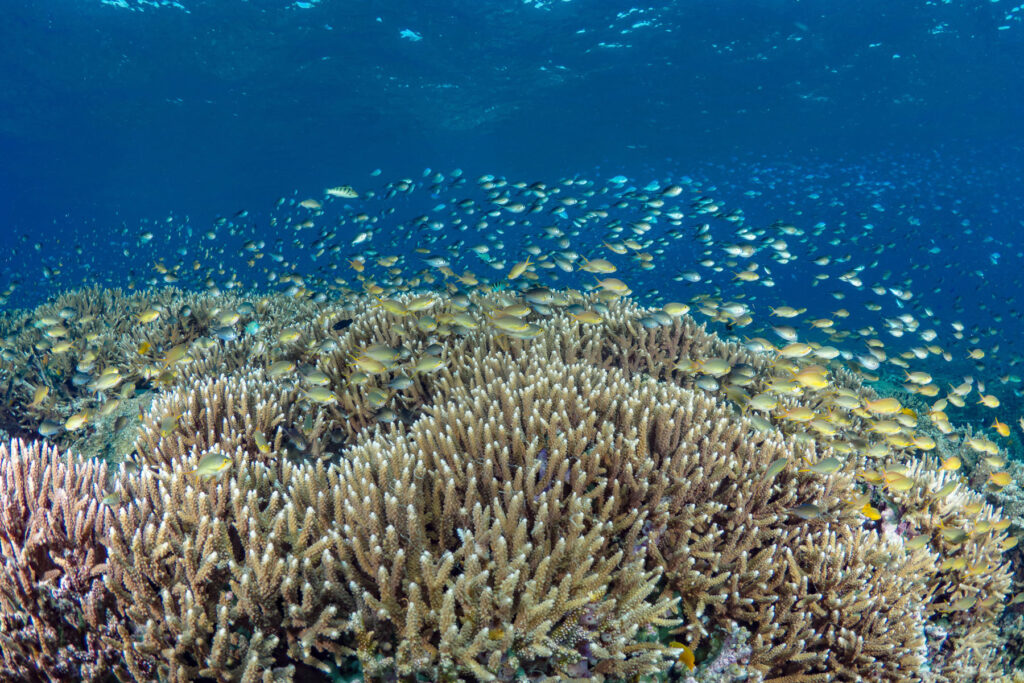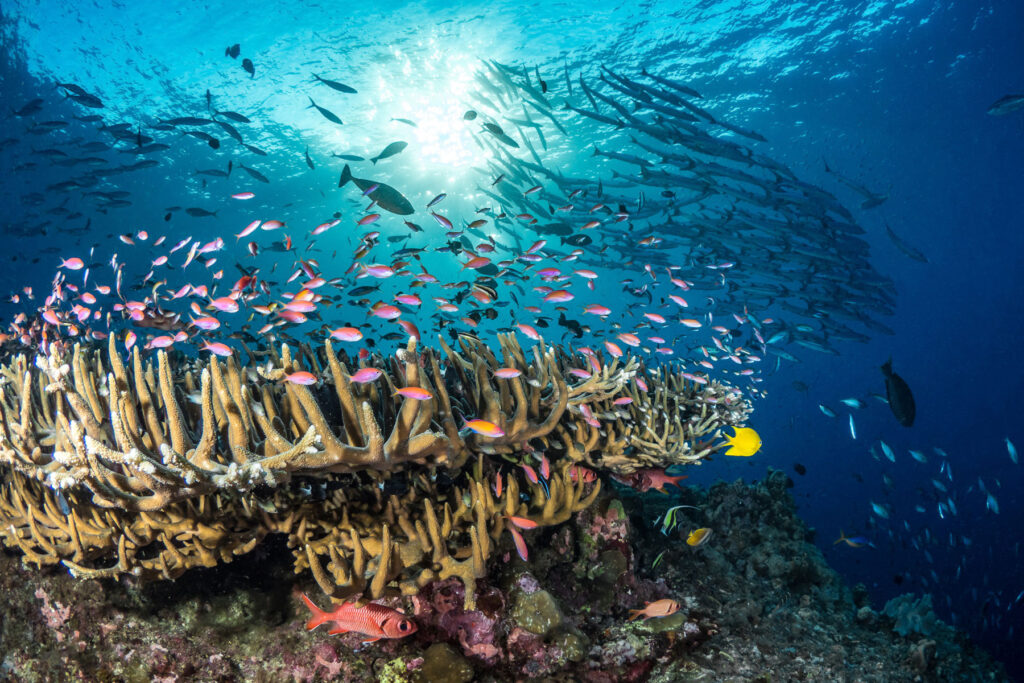The ripple effects of coral reefs reach nearly every coastline and community on the planet. Reefs support the seafood we eat, protect homes from storms, and provide ingredients for lifesaving medicines. But they’re in crisis. Half have already been lost, and nearly all could disappear by 2050 if we don’t intentionally act now.
The good news is that decades of science and collaboration have revealed what actually works – what actually reduces stressors and helps reefs better adapt to climate change. Around the world, conservationists have tested countless ideas, and four strategies consistently stand out for delivering real, measurable impact.
1. Create Well-Managed Marine Protected Areas
Healthy reefs need safe spaces to recover. Marine Protected Areas (MPAs) act as sanctuaries where fish can reproduce, corals can regrow, and ecosystems can balance naturally. But the secret isn’t just declaring protection—it’s enforcing it effectively.
When MPAs are managed with local leadership, clear rules, and long-term funding, they restore fish populations, stabilize reef structures, and boost biodiversity. Studies reveal that fish biomass inside well-enforced MPAs can be several times higher than that in unprotected areas, helping adjacent fisheries rebound, too. These ecological gains ripple outward, feeding families and sustaining coastal economies.
Yet globally, only 6% of coral reefs are situated within effectively managed Marine Protected Areas (MPAs) that successfully mitigate threats. This leaves ~66 million acres of coral reefs unprotected. Expanding and improving MPA governance/management is one of the most impactful investments we can make for ocean health because positive change happens significantly and quickly.
Strategy in Action
In Fiji and Honduras, the Coral Reef Alliance has experience working with Indigenous leaders and coastal fishers to strengthen MPA enforcement and financing, resulting in dramatic increases in fish biomass and community income. Our long-term goal: ensure 75% of reef-connected protected areas worldwide are effectively managed by 2050.
Protecting coral reefs through well-managed MPAs revives fisheries, strengthens coastlines, and builds ecological resilience.
2. Build Climate-Resilient Reef Networks
No single reef can face climate change alone. Rising ocean temperatures, acidification, and bleaching events are reshaping marine ecosystems, but reefs have one powerful advantage: adaptability.
Genetic diversity and ecological connectivity allow coral larvae to drift between reef systems, carrying heat-tolerant traits that help reefs evolve and recover after stress. Protecting large, connected networks of reefs strengthens this natural resilience. When one area suffers bleaching, nearby reefs can reseed it—nature’s version of a safety net.

Creating “climate-smart” reef networks means using data, satellite imagery, and community knowledge to identify which connected/adjacent areas of reef have a higher chance of adapting to environmental changes, and then can repopulate other less-resilient reefs. By protecting these networks of more resilient reefs, we support the ocean’s ability to heal itself.
Strategy in Action
Through our Roadmap to Reef Resilience, CORAL helps governments integrate adaptation science into reef management plans. The goal: ensure 80% of coral reef regions globally include climate resilience strategies by 2050.
Building connected, climate-resilient reef networks keeps coral adaptation alive and keeps ecosystems functioning in a changing world.
3. Reduce Land-Based Pollution
The fight for coral reefs often begins miles inland. Runoff from farms, cities, and inadequate sewage systems carries nutrients and waste that suffocate coral and feed algae blooms. In fact, 104 of 112 major nearshore coral reef systems have sewage problems,1 and, in the Pacific Islands, an alarming amount of reefs are negatively affected by sedimentation.
Clean water is foundational for reef health. When pollution is reduced, corals are less stressed. Coral cover can then increase, fish return, and entire ecosystems rebound. Straightforward interventions like upgrading wastewater systems, managing stormwater, and restoring coastal vegetation can dramatically improve water quality and reef survival.
Better management of wastewater is one of the fastest, most cost-effective ways to protect reefs because it addresses the problem before it reaches the ocean.

Strategy in Action
On the island of Roatan, Honduras, CORAL and local partners prevent more than 30 million gallons of sewage from reaching the reef each year by supporting adequate wastewater treatment and monitoring. By 2030, we aim to have expanded this initiative to 400 million gallons of sewage across several reef regions, setting new global standards for ocean-clean water policy.
Reducing pollution on land directly improves coral health and protects the communities that depend on reefs.
4. Expand Global Collaboration and Policy Influence
Reef conservation succeeds when local knowledge and global action move in sync. Coral reefs span political boundaries, and saving them requires coordination across governments, NGOs, and industries. Without aligned policy and investment, even the best local work can stall.

Global collaboration creates the framework for large-scale success, linking science, funding, and enforcement. It shapes national policies, guides sustainable tourism, and channels billions in conservation finance. Advocacy at the global level ensures reefs are included in climate and biodiversity agreements, keeping them visible on the world’s agenda.
Strategy in Action
As an active member of the International Coral Reef Initiative (ICRI) and other alliances that push the needle on coral conservation regulation, CORAL leverages its field experience to inform global policy and investment. Our long-term goal by 2050: mobilize a $100 million pipeline of reef-positive funding and ensure that every major reef region benefits from coordinated, science-based conservation.
Global collaboration transforms proven local success into policies and funding that protect reefs at a planetary scale.
Why These Four Strategies Matter
These aren’t abstract ideas. They’re the roadmap for reef survival in the face of global stressors like climate change and local stressors such as wastewater pollution and overfishing.
Together, these strategies tackle the layers of the coral reef crisis:
Protection keeps ecosystems intact.
Resilience ensures reefs adapt to climate change.
Clean water removes the most direct local threats.
Collaboration scales impact and sustains progress.
When combined, they create a feedback loop of hope. Cleaner coasts, stronger fish populations, healthier reefs, and communities that thrive alongside them.
Everyone has a role to play.
Whether you reduce single-use plastics, support sustainable seafood, or donate to conservation programs such as ours or those of our partners, your choices flow downstream (literally) to the reef.
1 – Wear, Stephanie L (2015). Sewage pollution: mitigation is key for coral reef stewardship. Annals of the New York Academy of Sciences 1355: 15-30.



